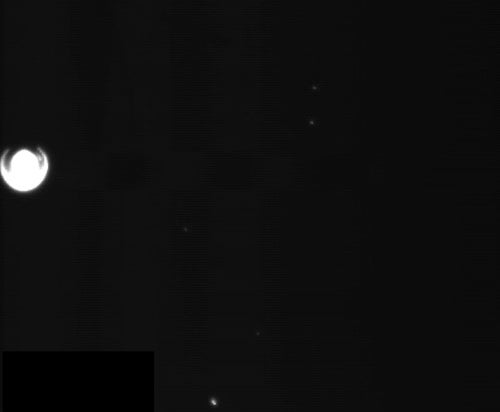The MOC imager on NASA’s Mars Global Surveyor orbiter appears to have located the Mars Polar Lander spacecraft, which vanished without a trace on landing in December 1999. The loss of the spacecraft was a big setback to NASA’s Mars exploration plans and forced changes in unmanned spacecraft design, for example, to include a radio tracking signal emitted during entry, descent, and landing.
Mars Polar Lander (MPL) was sent to a site near the edge of the planet’s southern polar cap. It also carried two small, hard-landing impact probes, both of them lost as well. A non-roving lander, MPL had mission goals that included digging for ice and analyzing it. The Phoenix mission, due for launch in 2007, will seek to recover this part of MPL’s science.
After the loss of the spacecraft, an investigation board concluded that MPL had probably crashed when its descent rocket engine quit firing due to a software error at an altitude of about 130 feet (40 meters). The spacecraft would have dropped freely from that height, hitting the ground about as hard as falling 50 feet on Earth. But because MPL emitted no tracking signals as it descended, mission controllers have remained in the dark as to what really happened.
Soon after the loss, the MOC science team imaged the targeted landing area at a resolution of 60 inches (1.5m) per pixel. (MPL was about 3 feet tall and 10 feet wide.)
The scientists sought a bright, elongated feature (which could be the parachute) within about half a mile (1 kilometer) of a patch of dark soil with a tiny, bright spot near the center. This would be the lander surrounded with dirt disturbed by the rocket motor’s blast. One candidate site was found in 2000, but the image was inconclusive.
But with the experience of locating both Mars Exploration Rovers Spirit and Opportunity (and their associated debris) on the ground in 2004 — plus both Vikings and the Mars Pathfinder lander — the MOC team reexamined the 2000 image. Comparing it to the rovers’ debris, the team found the bright patch is about as bright as the rovers’ parachutes, and the darkened soil resembles that left by the rovers’ retrorockets. Moreover, the possible parachute lies about where it should, given the winds at the site on the landing day.
The MPL landing site is emerging from winter darkness now, and it has only begun to lose its carbon-dioxide frost cover. However, the site should be well-lit by the end of July and beginning of August 2005.
The MOC scientists will then try a special technique that increases the resolution of the camera to about 20 inches (0.5m) per pixel. Mission controllers give the spacecraft a slow, smooth roll during the exposure. This keeps the camera aimed at a single point on the ground and all but eliminates any blur due to the spacecraft’s orbital motion.
With luck, the team hopes to be able to tell if the mysterious markings on the ground really are the long-lost spacecraft.
If MPL has been located, that leaves only Britain’s Beagle 2 lander still unaccounted for. It was last seen by the European Space Agency’s Mars Express orbiter (which ferried it to Mars) on Christmas Day 2003, when Beagle 2 separated from Mars Express, heading for a touchdown in Isidis Planitia. It was never heard from again.
The MOC science team photographed Beagle 2’s targeted landing area in 2004 and into 2005 at 60-inch resolution. But the team was unable to spot anything that could plausibly be the lander or its wreckage — or even possible associated hardware such as a parachute or heat shield.
Explains Ken Edgett of Malin Space Science Systems, the company that built and operates the MOC, “We continue to occasionally fly over the landing ellipse, and we take 1.5 meter per pixel images of that area in hopes of seeing something.” But without a good candidate site, he says, forget about searching with the very high-resolution technique.
“It would take years to cover the landing ellipse.”











